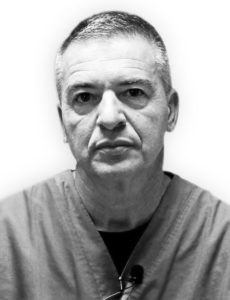Medical doctors and Surgeons
Lipoedema and lymphoedema: doctor Corda explains the differences
«It’s impossible to heal from lipoedema, but it is possible to contain it, contrast it and finally improve quality of life»
MD Domenico corda, lymphologist and physiatrist, lipoedema and lymphoedema expert and founding member of ila
MD Domenic Corda, lymphologist and physiatrist, has been dealing with lymphology and lymphostatic diseases for 25 years. He is a full-time lymphologist, and in his career he has handled lymphoedema but also lipoedema, which until some years ago was considered a lymphatic system disease. Nowadays, recent observations have disproved this hypothesis. Lipoedema and lymphoedema have differences, and the expert Domenico Corda has meticulously studied them.
What is lipoedema and why is it different from
lymphoedema

Lipoedema and lymphoedema are pathologies that may at first look related, and even the name, which is similar, may cause confusion. However, they are different diseases, and lipoedema has very little in common with lymphoedema. «The name “lipoedema” has misled people for years» Corda acknowledges. «Truth is, the word “oedema” has fooled everyone and for almost 80 years lipoedema has been treated as if it was an oedematous disease of the lymphatic system, using the same therapy that was and is used to tackle lymphoedema». CDP, Complex Decongestive Physiotherapy, is a cluster of therapies that target oedemas and lymphoedema in particular, however it is not effective at treating lipoedema.
This disease is not as well-known as others and what causes it is still a mystery. Doctors have thus tried to define lipoedema in light of its differences from lymphoedema. «As it stands now, we can define lipoedema as a pathology or a syndrome that targets the adipose organ, influenced by an internal inflammatory process» the doctor continues, saying that even if lipoedema still has not been fully researched, at least it is now known it is not linked to the lymphatic system. «We now know what lipoedema is not, and with what it has been confused for almost 80 years, considering that it presents no alterations of the lymphatic system unlike lymphoedema».
Recent studies verified that patients suffering only from lipoedema do not show any onset of oedema or lymphatic problems, using ultrasound scans and magnetic resonance imaging (MRI). This is the reason why the ILA (International Lipoedema Association) was founded. MD Domenico Corda is a member, and together with 70 other esteemed lymphologists, wrote an innovative consensus document about lipoedema. «In 2018 we prepared this document that starts from scratch. It is a paradigm shift, a copernican revolution, as it is based on the fact that lipoedema is not a disease of the lymphatic system and not even an oedematous pathology. This prompted doctors to change their therapy planning for patients that even today waste money on ineffective lipoedema therapies such as manual lymphatic drainage» Corda says.
Lipoedema symptoms and when do they appear
Lipoedema is a pathology tied to family history. Often, lipoedema symptoms in a young girl can be similar to symptoms shared by her mother or her grandmother, even if sometimes the disease can skip a generation or several, as it almost never affects males. «It is a pathology that is influenced by estrogens – Corda adds – and even if we still do not know the exact relationship between estrogens and adipose tissue, we know that these hormones regulate this relationship». This is clear when seeing the different ways fat is stored depending on sex.
Classic symptoms of lipoedema start with the first periods, and become more evident around 14-16. «Signs are an exaggerated dysmorphism, leading to a perceived asymmetry of normal ratios between the lower and the upper body. Women affected only by lipoedema tend to have big legs, a thin waist and a normal thorax» says Corda, highlighting that sometimes lipoedema may sometimes target upper limbs. The difference between lipoedema and lymphoedema is that while in the case of lymphoedema there are liquid oedemas, lipoedema shows a solid swelling.
However, pain is the most evident symptom of women with lipoedema. «When patients come to me they usually present large legs, however the main point is that they feel pain» the doctor explains. If pain is absent, the person may be affected by lipohypertrophy; but if pain is present, then the probable diagnosis is lipoedema.
Therapy and surgery to fight lipoedema
In past years doctors, mistaking lipoedema with lymphoedema or obesity, prescribed therapies or surgical operations that were unfit for the patients, such as bariatric surgery. Actually, pure lipoedema (without comorbidities) has nothing to do with neither obesity nor the lymphatic system, although the pain felt while moving and the difficulty in accepting a body perceived as asymmetric may lead towards obesity. «The patient undergoes a lengthy physical not to diagnose lipoedema, which is something easy to assess for an expert. The physical aims to check if the patient has comorbidities and what is their overall status» Corda continues, saying that it is hard to make patients understand that what they have is lipoedema when they have been told for years they suffered from lymphoedema.
One of the key points patients have to understand, Corda says, is that lipoedema cannot be cured. However, it can be treated to contain it and to improve the patients’ quality of life, thanks to new medical practices that have been developed in recent years. The doctor explains that using a compression stocking, also called a brace, is helpful in dealing with the symptoms. «Lipoedema is an inflammation of the adipose organ, but it doesn’t respond well to classic steroidal and non-steroidal anti-inflammatory medications. On the other hand it responds well to compression stockings». The use of these stockings has to be done in tandem with physical activity, such as a daily 1-hour walk, in order to achieve the best results. The brace is useful in this aspect too, since it relieves the amount of pain felt by patients with lipoedema that often are not physically active simply because the pain when moving is too strong.
After undergoing this kind of therapy for some time, Corda says that the next step may be bariatric or plastic surgery, if needs be. «Surgery may prove to be helpful, but we need to be careful and neither perform bariatric surgery on patients who only have lipoedema, nor perform liposuction on obese patients» Corda warns. Before thinking about surgery, however, the ILA consensus document advises patients to follow therapy for at least 1 year. «Liposuction is not the solution to our problems, it doesn’t heal lipoedema and simply removes some subcutaneous fat. The disease remains». In this case, other than compression stockings patients need post-operative garments to make sure these surgeries restitute the best results.
Lipoedema and obesity: can they be prevented?
Lipoedema, being a genetic disease without a clear-cut cause, cannot be prevented. However, it is possible to prevent and manage comorbidities in order to have a high quality of life. It is of utmost importance to make sure patients with lipoedema have a good nutrition plan. «Eating well is important, because lipoedema can worsen if it is associated with obesity, since it is a disease that targets subcutaneous fat» Corda specifies. «To gain weight means to gain more subcutaneous fat. So, if the patient is overweight or obese, losing this fat is incredibly important».
It is also useful to intervene against lipoedema when patients are young, both to identify the disease and then to treat it. Young women often mistake the disease with other pathologies such as obesity, or with aesthetic problems such as cellulitis and water retention. «The earlier we intervene, the easier it is for patients to maintain a normal silhouette» Corda says, highlighting how young girls greatly suffer from aesthetic problems. «This is the phase where it is important to intervene as soon as possible; instead it is the most misunderstood one» the doctor insists, pointing out that raising awareness in both patients and doctors on lipoedema is as important as therapy and surgery, also to emphasise the difference between lipoedema and lymphoedema and avoid wrong or harmful treatments.




































